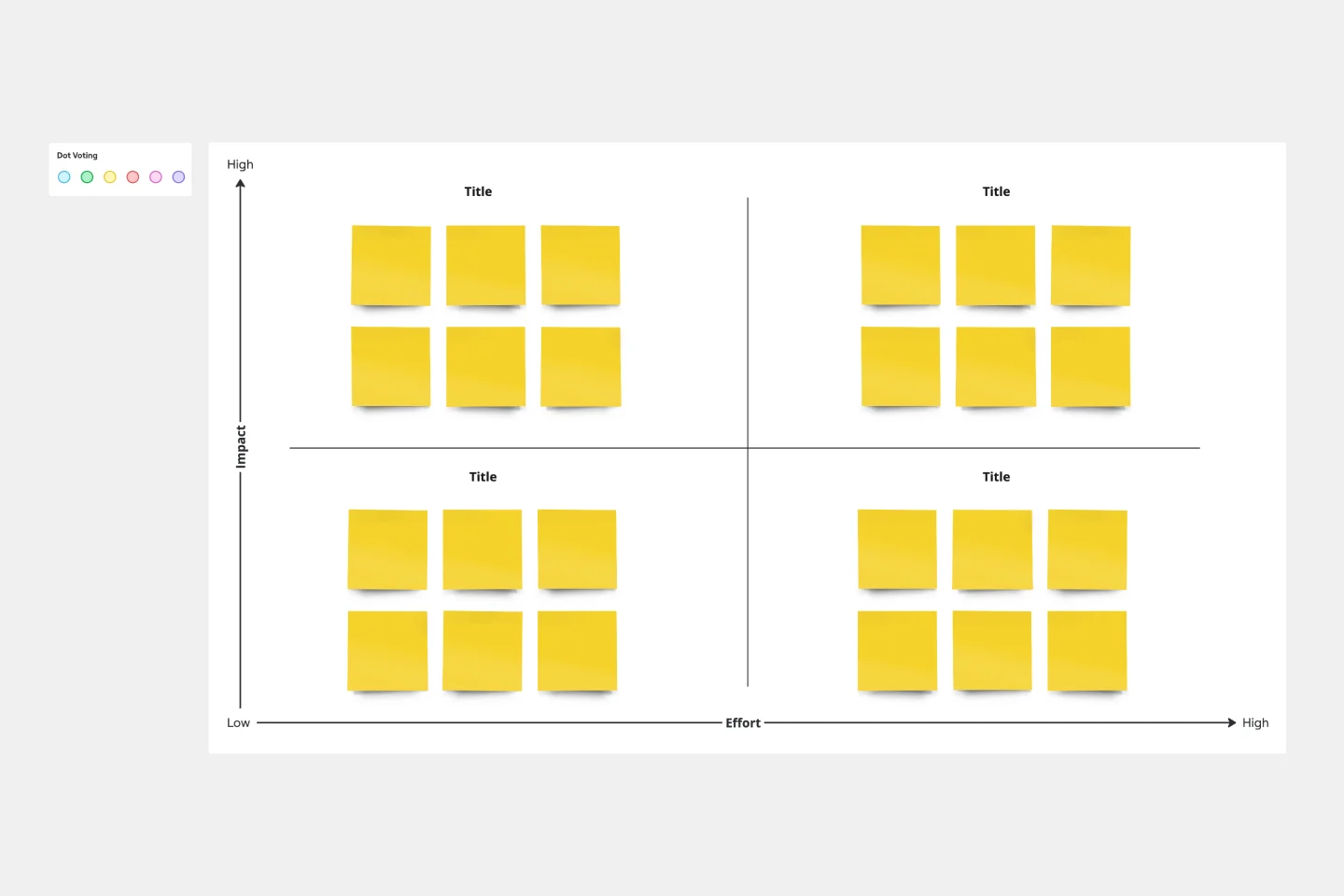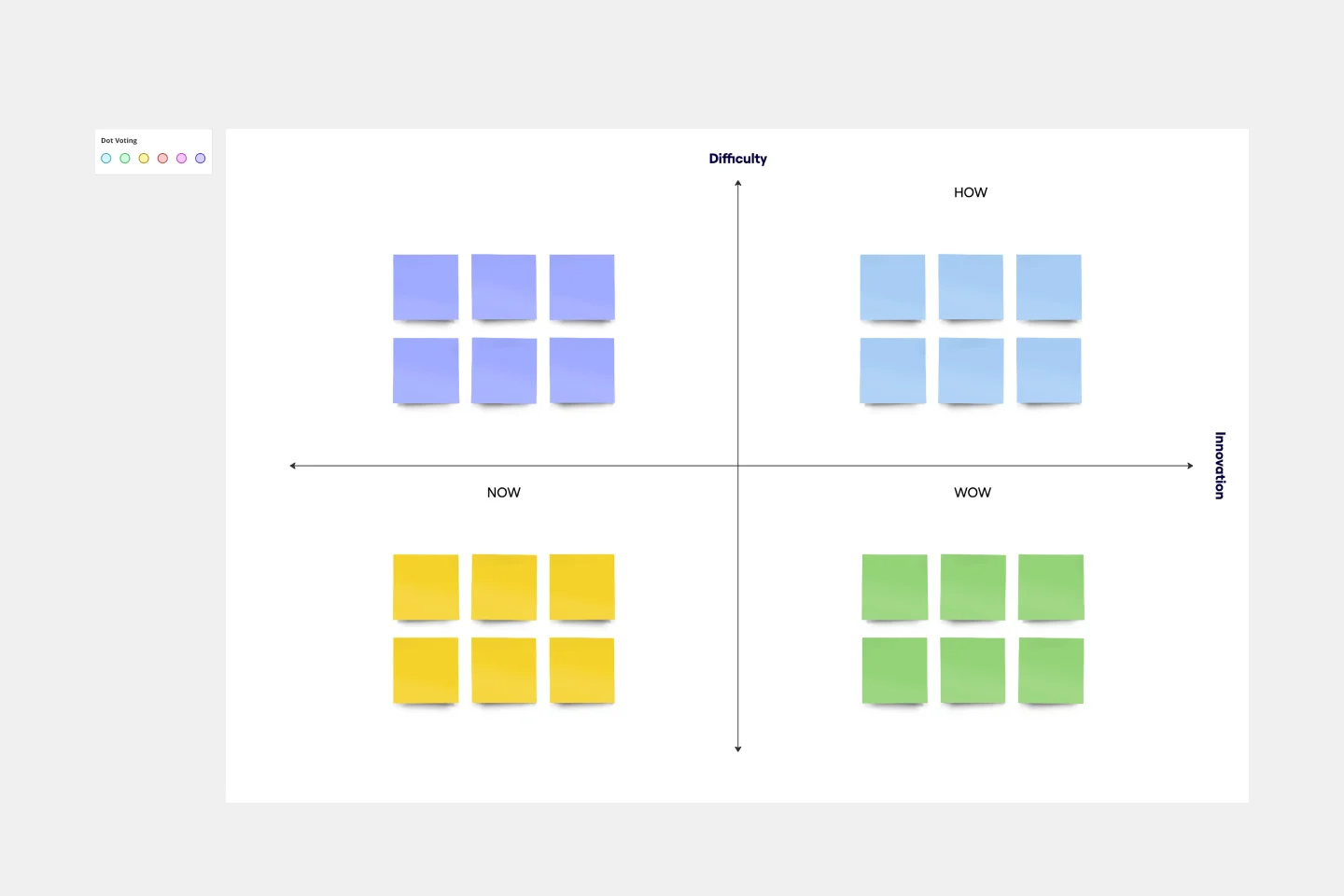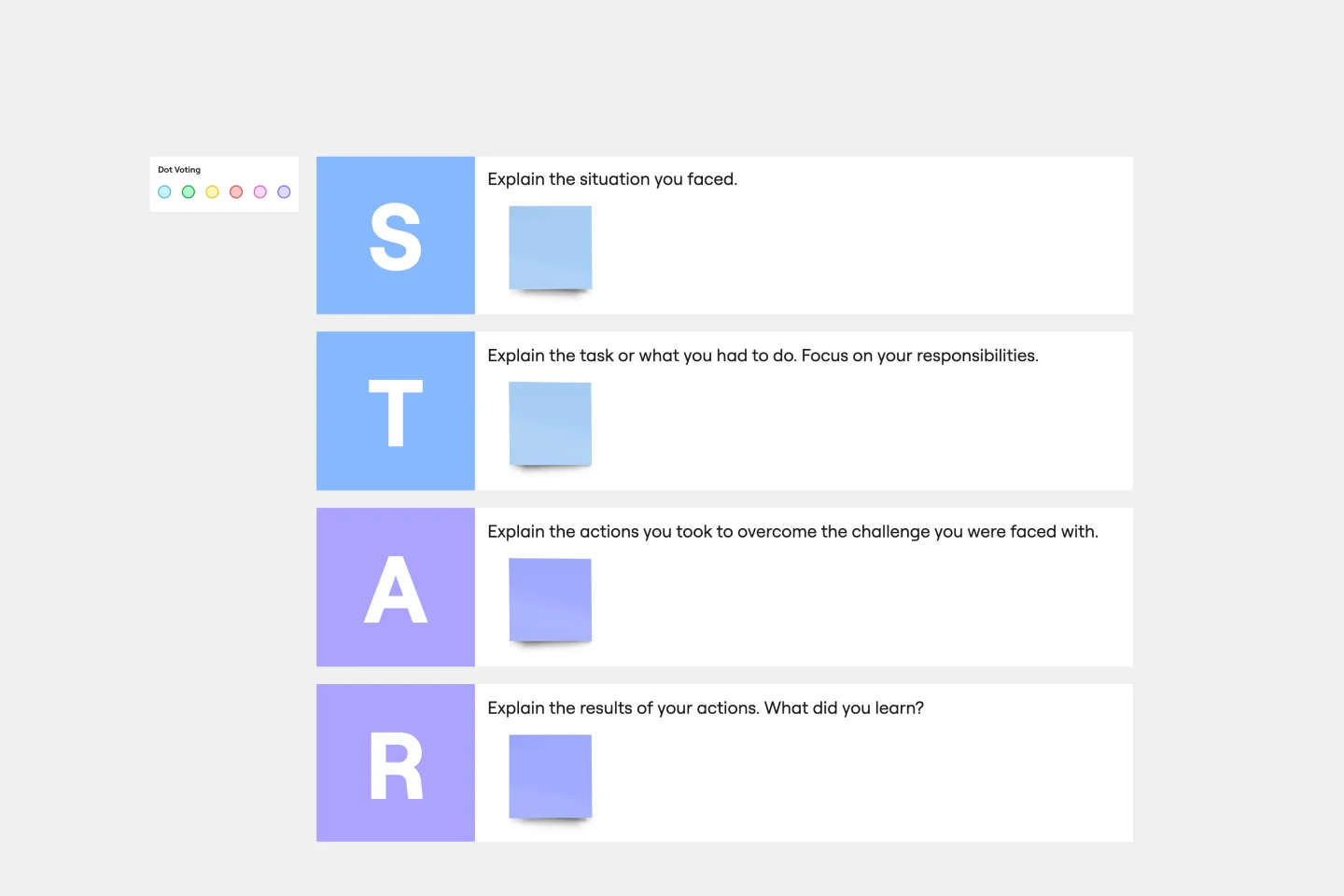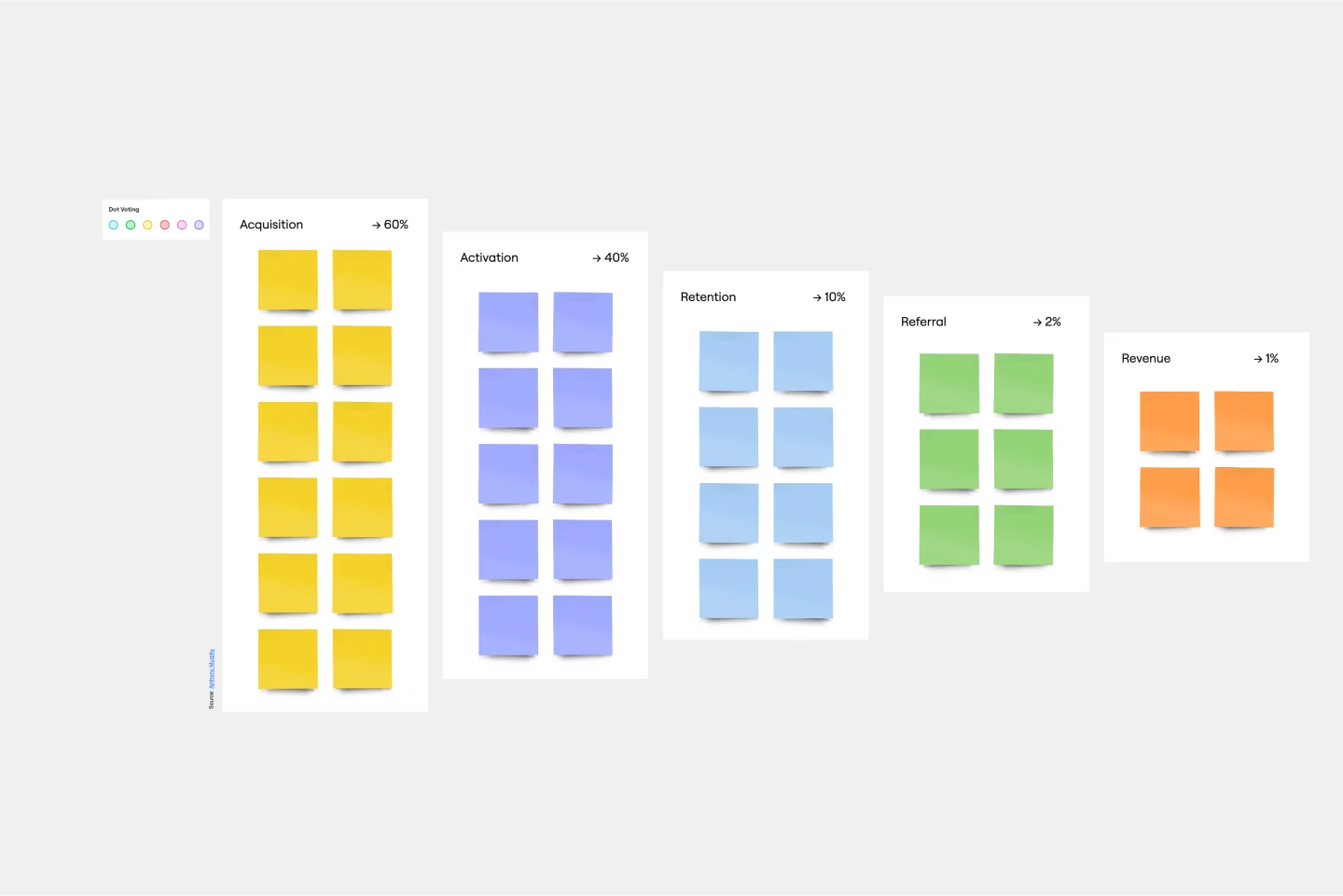Prioritization templates
83 templates
Action Priority Matrix Template
0 likes
26 uses

Action Priority Matrix Template
You and your teammates probably have more ideas than resources, which can make it difficult to prioritize tasks. Use an Action Priority Matrix to help choose the order in which you will work on your tasks, allowing you to save time and money and avoid getting bogged down in unnecessary work. An Action Priority Matrix is a simple diagram that allows you to score tasks based on their impact and the effort needed to complete them. You use your scores to plot each task in one of four quadrants: quick wins, major projects, fill-ins, and thankless tasks.
Prioritization Template
3 likes
25 uses
Banana Idea Prioritization
11 likes
23 uses
Product Roadmap Template
0 likes
23 uses

Product Roadmap Template
Product roadmaps help communicate the vision and progress of what’s coming next for your product. It’s an important asset for aligning teams and valuable stakeholders – including executives, engineering, marketing, customer success, and sales – around your strategy and priorities. Product roadmapping can inform future project management, describe new features and product goals, and spell out the lifecycle of a new product. While product roadmaps are customizable, most contain information about the products you’re building, when you’re building them, and the people involved at each stage.
How Now Wow Matrix Template
0 likes
20 uses

How Now Wow Matrix Template
There are no bad ideas in a brainstorm — but some are more original and easier to implement. The How Now Wow matrix is a tool that helps you identify and organize those great ideas, as well as reinvigorates your team to think creatively and take risks (a taller order as you scale). Grab this template to create your own matrix, then rank the ideas you generated in a brainstorm as “How” (difficult to implement), “Now” (easy to implement), or “Wow” (both original and easy to implement).
STAR Technique Template
0 likes
20 uses

STAR Technique Template
Find out how to use the STAR interview method to identify the best candidate for the role. Interviewees can also use the STAR technique to prepare detailed and thorough responses during the interview.
Pickle Jar (Priority Jar)
5 likes
18 uses
Strategic Group Mapping Template
0 likes
17 uses

Strategic Group Mapping Template
The Strategic Group Mapping Template is a cutting-edge visual tool designed to translate the competitive landscape of their industry. By allowing users to plot entities based on distinct criteria, this template provides an at-a-glance view of market dynamics. One standout benefit of using this tool is its ability to identify clusters of competitors and market gaps, paving the way for businesses to strategically position themselves for optimal success.
FMEA Analysis Template
0 likes
17 uses

FMEA Analysis Template
When you’re building a business or running a team, risk comes with the territory. You can’t eliminate it. But you CAN identify it and mitigate it, to up your odds of success. Failure Modes and Effects Analysis (FMEA) is a powerful tool designed to help you manage risk and potential problems by spotting them within a process, product, or system. And you’ll spot them earlier in your process—to let you sidestep costly changes that arise late in the game or, worse, after they’ve impacted your customers and their experience.
Bull's Eye Diagram Template
1 likes
15 uses

Bull's Eye Diagram Template
When you’re a growing organization, every decision can feel like it has make-or-break consequences—which can lead to decision paralysis, an inability to prioritize, inefficient meetings, and even low morale. If that sounds like you, put a Bull’s Eye Diagram to work. True to its name, a Bull’s Eye Diagram uses a model of concentric circles to help companies establish priorities, make critical decisions, or discuss how to remove or overcome obstacles.
Project Prioritization Grid
5 likes
14 uses
Conversion Funnel Backlog Template
1 likes
14 uses

Conversion Funnel Backlog Template
If you’re working on a product that has clear conversions, then it can help to structure your backlog around the conversion funnel to make sure you’re reaching your audience. Creating a conversion funnel backlog brings together information around potential pain-points in your funnel and opportunities for growth. Once you’ve identified that information, it becomes easier to prioritize. You and your team can use the conversion funnel backlog to focus on conversion, retention, and referral, or to tweak your workflow in more mature products.

Explore more
About the Prioritization Templates Collection
In project management, making informed decisions about what tasks to tackle first can be a game-changer. Miro's prioritization templates collection is designed to help teams streamline their decision-making processes, ensuring that the most critical tasks are addressed promptly. This collection includes various prioritization frameworks, such as the prioritization matrix template and the project prioritization matrix template, which are essential tools for any team looking to optimize their workflow.
Why you'll love our prioritization frameworks
Prioritization frameworks are invaluable for teams aiming to enhance productivity and focus on what truly matters. Here are some key benefits of using Miro's prioritization framework templates:
Clarity and focus: These templates help teams clearly define and visualize their priorities, ensuring everyone is on the same page.
Improved decision-making: By using a structured approach, teams can make more informed decisions about which tasks to prioritize.
Enhanced collaboration: The visual nature of these templates fosters better communication and collaboration among team members.
Time efficiency: Streamlining the prioritization process saves time, allowing teams to focus on execution rather than deliberation.
Flexibility: Miro's templates are customizable, making them suitable for various projects and team needs.
How to use the prioritization templates in Miro
Using Miro's prioritization templates is straightforward and can significantly improve your team's workflow. Here's a step-by-step guide:
Select a template: Choose a prioritization framework template that best suits your project needs. Miro offers a range of options, including the prioritization matrix template and the project prioritization matrix template.
Define criteria: Establish the criteria for prioritization. This could include factors such as urgency, impact, effort, and resources required.
List tasks: Compile a comprehensive list of tasks or projects that need prioritization. Ensure that all relevant tasks are included to get a complete overview.
Evaluate tasks: Assess each task against the defined criteria. This step involves scoring or ranking tasks based on their importance and urgency.
Visualize priorities: Use the template to plot tasks on a matrix or chart. This visual representation helps in quickly identifying high-priority tasks.
Review and adjust: Review and adjust the prioritization regularly to ensure it remains aligned with project goals and any changes in circumstances. Adjust priorities as needed.
Execute: Once you have a clear understanding of your priorities, begin executing the tasks in order of importance. This ensures that the most critical tasks are addressed first, leading to more efficient project completion.
Monitor progress: Regularly track the progress of your tasks using the prioritization framework template. This helps in identifying any bottlenecks and making necessary adjustments to stay on track.
Communicate: Keep your team informed about the prioritization and any changes that occur. Effective communication ensures that everyone is aligned and working towards the same goals.
Review and reflect: After completing the tasks, review the outcomes and reflect on the process. This helps in understanding what worked well and what can be improved for future projects.
How Miro's prioritization templates help teams thrive
Miro's prioritization templates are more than just tools; they are enablers of success. By providing a structured approach to prioritization, these templates help teams to:
Achieve goals faster: By focusing on the most important tasks, teams can achieve their goals more quickly and efficiently.
Enhance team morale: Clear priorities reduce confusion and stress, leading to a more motivated and cohesive team.
Drive innovation: With less time spent on deliberation, teams can dedicate more time to creative and innovative tasks.
Adapt to changes: The flexibility of Miro's templates allows teams to easily adapt to changes in project scope or priorities.
Miro's prioritization templates are essential for any team looking to optimize their workflow and achieve their goals efficiently. By using these templates, teams can ensure that they are always working on the most important tasks, leading to better outcomes and a more productive work environment.



